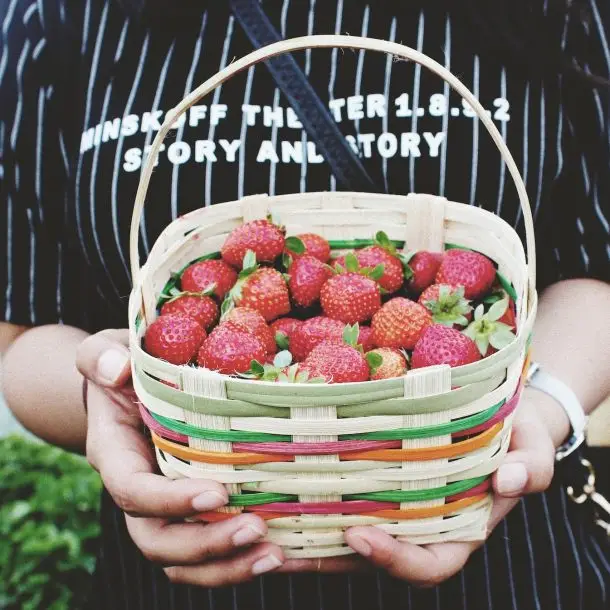

Did you know that August is Breastfeeding Awareness Month?
The decision to breastfeed or not is an incredibly personal journey, and one that is your journey alone.
If you do choose to breastfeed, please continue reading my tips ‘n tricks to help you thrive in your breastfeeding journey.
And if you choose to not breastfeed, or simply cannot, there’s no judgment. You may find this post triggering, and there’s no hard feelings if you close this tab and move right along.
I believe that mamas deserve to be celebrated for whatever decision they make to feed their babe!
♥ If you are a bottle-feeding mama, I see you.
♥ If you have been hooked up to your pump for what feels like forever, I see you.
♥ If you made it through your breastfeeding journey – figuring out a latch, sore nipples, cluster feeding, clogged ducts, pumping, and so much more – I see you.
How ever you choose to feed your baby, I see you. And I celebrate you!
If this post doesn’t answer all of your questions, make sure to check out Mama and Baby Blog Series: Breastfeeding, where I go into even more detail about the world of breastfeeding!
The human body is pretty incredible. You grew a human. FROM CELLS. And you birthed a human, whether it was vaginal or cesarean, a human being came out of your body and that deserves a round of applause! But even more incredible —
You make food with your body.
You not only keep your baby alive — you make the most perfect formulation of liquid that allows your child to grow and thrive, mama. It’s amazing.
… except for when it’s not.
Because, let’s be honest, at times, breastfeeding can be difficult, painful, isolating, emotional, triggering, and for some, downright impossible.
It’s a journey — one that’s different for each mom and baby.
But, guess what?
Knowledge is power, mama.
I’ve put together my top tips ‘n tricks to help you not only survive your breastfeeding journey, but thrive in it!
Here’s the thing — you’re going to be exhausted after the marathon of pregnancy, birth, and sustaining this beautiful new babe that is now earth-side.
Even though you’re probably constantly hungry, feeding yourself may be the last thing on your priority list. But, the reality is, it’s one of, if not the most, important thing for new mamas to focus on. Food is what’s going to keep you (AND baby) going, providing you with sustainable energy.
New breastfeeding mamas need, on average, an additional 500 calories per day. Those additional calories should come from clean, nutrient-dense foods.
Here are some tips and tricks to help you get the nourishment you need:
If you eat animal products, always buy organic!
Breast milk contains quality fats that nourish your baby’s growing brain. Remember that fats attract and store fat-soluble chemicals, so the more you avoid hormones, chemicals, and toxins, the less ends up in your breast milk.
Aim to eat wild fish and seafood several times per week. Fish is the best place to get fully-formed EPA and DHA, both of which are critical for brain development, so make sure you’re consuming it at least 2-3 times per week.
Including healthy fats and high quality protein at every meal and snack will help to stabilize blood sugar levels, alleviating unnecessary stress on mama’s body, allowing for more energy to be diverted to making milk for baby. Think organic grass-fed meats, pasture-raised chicken & pork, organic eggs, wild caught fish & seafood, beans, lentils, avocados, olive oil, coconut oil, raw nuts & seeds, and grass-fed butter or ghee.
Consume lots of full fat coconut milk, coconut oil, and coconut butter. Coconut is the richest food source of lauric acid, which helps build your baby’s immune system.
Foods like egg yolks and grass-fed liver contain choline, which is critical for brain development and is the precursor to acetylcholine, important for memory and learning.
Eat meals and snacks at regular intervals throughout the day. Don’t skip meals. No exceptions!
Eat at least one large, satisfying, nourishing meal every day to produce necessary oxytocin.
Cooked, warm foods should form the basis of your postpartum diet.
Drink at least half of your body weight in ounces of clean, filtered water every single day. You’re going to want a large bottle of water on every surface in your house because breastfeeding makes you so dang thirsty!
Obviously your lifestyle is going to change with a baby at home, but there are a few tweaks that can make your breastfeeding journey a bit more enjoyable:
If you choose to consume them, make sure to choose the highest quality of both. This means making sure your coffee beans are organic, and choosing organic, lower sugar varieties of wine if you choose to drink.
Get as much RESTORATIVE sleep as you can.
Yes, I know that’s easier said than done with a baby, but make the sleep that you do get, count.
Remember that your body is healing after a traumatic (and beautiful) event, and sleeping is when your body does it’s best healing.
Clean up your environment: always choose organic, replace toxic body care products and cleaning supplies, filter your water, and avoid unnecessary chemicals in plastics, non-stick cookware, and other toxic household items.
Try to get outside for a walk with your baby in the carrier or stroller as many days as possible. Even if it’s just for 15 or 30 minutes. It all counts!
Get a minimum of 15-20 minutes of direct sun exposure each day without sunscreen to optimize your vitamin D levels.
Find time to let go, disconnect, unwind, and have fun each day.
Breathe deep into your belly, meditate, and quiet your mind.
Understanding how milk production works can help a mama ensure that her baby is getting enough milk at the breast. For example, sometimes mothers feel that their baby has completely emptied their breast and that there is no more milk available, even though the baby wants to nurse. Knowing that new milk is constantly being produced will give a new mama the confidence she needs to put her baby to the breast, even when it feels “empty.”
Emptying the breasts is what keeps milk production going. A baby’s sucking sends messages to the brain, which then releases the hormone oxytocin. Oxytocin causes the muscle cells around the alveoli to contract, pushing milk down through the ducts to the nipple. This movement of milk down the ducts is called the milk-ejection reflex. Mamas may experience it as a tingling feeling or a sense of release in the breast, which is why it is also called the “let-down.” The let-down empties the alveoli and makes the milk available to the baby at the nipple. When the alveoli are empty, they respond by making more milk.
To ensure that you are properly “emptying” your breasts and promoting further milk production:
* If baby empties the breasts well, then pumping is more useful if done between nursing sessions (in light of our goal to keep the breasts as empty as possible).
Low milk supply can be a huge concern for breastfeeding mamas, but there are plenty of herbs, supplements, and healthy foods that can ensure your supply is solid. Here are my top recommendations:
Every meal should include galactagogue foods (foods that promote or increase the flow of a mother’s milk) like oatmeal, leafy greens (chard, kale, spinach, broccoli), garlic, chickpeas, nuts and seeds (especially almonds), ginger, and papaya.
Also at every meal, drink teas containing herbs like fennel, anise, coriander (cilantro), fenugreek, blessed thistle, goat’s rue, milk thistle, caraway seed, nettle, and red raspberry leaf (I like the Traditional Medicinals Mother’s Milk tea, but there many brands to choose from. Just make sure the tea you choose is organic).
Take Vitamin D to support your baby’s healthy teeth and bone development, and Vitamin B6, B12 and zinc to bolster your immune system and nervous system.
Consume wild caught fish 1-3 times per week to get fully-formed EPA & DHA; critical for baby’s brain development.
Make sure to include plenty of healthy and high quality fats in your diet—choose organic, grass-fed butter and ghee, raw coconut oil, extra-virgin olive oil, fish oil, raw nut butters, avocados and olives.
Include clean, high quality protein at every meal and snack from sources like grass-fed beef, game meat, pastured poultry, and pastured eggs.
And remember, if you’re struggling and/or your baby isn’t gaining weight, talk to a lactation consultant and to your baby’s paediatrician. Fed is best!
Does it feel like your sugar cravings are out of control?!
New mamas – breastfeeding or not – tend to be in survival mode for the first few months. When you combine lack of sleep and anxiety and overwhelm, the result is reactionary eating. Meaning you’re emotional, tired, and starving, so when hunger strikes your body wants quick easy- to-access energy stat which often means sugar (or things that turn into sugar like carbs – baked goods, breads, crackers and pasta).
Be honest – when you’re in the moment, are you grabbing a handful of nuts and half of an avocado? Or, are you grabbing a handful of crackers, chips, chocolate or a brownie?
But, what’s the underlying reason behind these sugar and carb cravings, especially in breastfeeding mamas? It could be any one of, or a combination of, the following:
Mineral Deficiencies: chromium and magnesium are used to treat diabetes and help with blood sugar control. These essential minerals can be lost in our diets because of the way food is grown, harvested, and fertilized. As a new mama, you may not be eating the rainbow of fruit, veg, and clean protein, and without a diet full of whole foods, you’re definitely missing out on chromium and magnesium.
Low Protein: without enough protein, blood sugar levels are like a yo-yo — constantly going up and down. Adding in more high quality protein sources (eggs, lentils, grass-fed meat, nuts & seeds) can help you decrease sugar cravings, slow the absorption of sugar and carbs, and balance your blood sugar levels.
Stress and sleep deprivation: sleep deprivation and stress are common causes for sugar and carb cravings. When your brain is low on sleep, it craves glucose for immediate energy to compensate for the lack of sleep. Stress can also signal carbs because the dopamine reaction helps soothe and calm your brain. You can combat both with a B12 supplement – not only does B12 help with energy, it helps with the production of healthy red blood cells, which are essential for growing babes.
Not enough fiber: if you aren’t eating enough fiber, you’re probably feeling hungry all the dang time, and quickly after you’re done eating. Refined carbs and sugar have no fiber and fiber is the key to bulking up and filling your stomach. Combining fiber with protein is going to help you feel “full” and satiated, meaning sugary treats won’t sound appealing.
Lack of Vitamin D: low Vitamin D levels have been linked to lower serotonin levels, which can cause sugar cravings. Sunshine is the best [and quickest!] way to boost your vitamin D levels, but you can also find vitamin D in wild-caught fish, egg yolks, fish oil, mushrooms, and a high quality supplement.
Yeast is a normal part of everyone’s digestive system but if there’s an imbalance, an infection can set in.
It’s not uncommon for babies to get thrush from their mamas while breastfeeding, and often the infection can be passed back and forth between mama and baby. Thrush causes creamy white or yellow patches to appear on the sides, roof, gums, lips, and tongue of a baby’s mouth.
So … how do you prevent and get rid of it?
Change your diet: eliminate all sugars, refined grains, dairy, and refined/processed/packaged foods from your diet. These foods feed the yeast! Instead focus on consuming plenty of healthy fats, tons of high quality protein, and a plethora of vegetables & fruits. Make sure you have a high quality protein, a healthy fat, and tons of vegetables every time you eat!
Get outside: Yeast thrives in dark, moist places. Exposure to fresh air and sunlight is one of nature’s best cures. When possible, expose your nipples to the sun and let your baby be naked as much as possible too! If nothing else, expose your breasts to a few minutes of sunlight each day through a window.
Use towels, bras, and breast pads only once: Wash in HOT water, and use ¼ cup vinegar in the rinse water (for all your laundry) to help kill yeast. Weather permitting, hang them in the sun to dry (the sunlight kills yeast).
Coconut oil is your friend: Apply pure, raw, virgin coconut oil to your nipples and to baby’s mouth to help prevent passing the yeast back and forth. Pure virgin coconut oil is perfectly safe for babies, in fact the medium chain fatty acids found in pure coconut oil are very easily digested and are actually good for both you and babe! Pure coconut oil (not hydrogenated or refined in any way) is a great natural immune booster, and a great home remedy for thrush.
Though breastfeeding can work as a method of birth control, like any other form of contraceptive, it isn’t foolproof.
Breastfeeding can delay the return of your periods; however, you’ll ovulate before you have your first period.
Frequent and regular breastfeeding as a form of contraception is called lactational amenorrhoea method (LAM). LAM is about 98% effective BUT will only work in the following instances:
If you want LAM to work, don’t leave a gap between feeds of longer than 4 hours during the day, or 6 hours at night. And either don’t give other fluids or solid food to your baby at all, or only give your baby other liquids from time to time.
With LAM, your breasts need to supply ALL your baby’s suckling needs, so your baby shouldn’t have a soother or use a bottle. Your baby’s suckling stimulates the hormones that suppress ovulation.
Here’s the bottom line: if your menstrual periods have returned, you can assume that breastfeeding is no longer a reliable method of birth control. However, keep in mind that ~5% of women do ovulate and are fertile even before their first period!
It’s not uncommon for babies to get thrush from their mamas while breastfeeding, and often the infection can be passed back and forth between mama and baby.
To prevent and get rid of it: focus on consuming plenty of healthy fats, tons of high quality protein, and a plethora of vegetables & fruits; get outside—when possible, expose your nipples to the sun and let your baby be naked as much as possible too; use towels, bras, and breast pads only once; and apply pure, raw, virgin coconut oil to your nipples and to baby’s mouth to help prevent passing the yeast back and forth.
Though breastfeeding can work as a method of birth control, like any other form of contraceptive, it isn’t foolproof.
Frequent and regular breastfeeding as a form of contraception is called lactational amenorrhoea method (LAM). LAM is about 98% effective BUT will only work in the following instances: your baby is younger than six months old, your periods have not returned, and you are exclusively breastfeeding your baby on demand, both night and day.
Emptying the breasts is what keeps milk production going. A baby’s sucking sends messages to the brain, which then releases the hormone oxytocin.
Oxytocin causes the muscle cells around the alveoli to contract, pushing milk down through the ducts to the nipple. This movement of milk down the ducts is called the milk-ejection reflex. Mamas may experience it as a tingling feeling or a sense of release in the breast, which is why it is also called the “let-down.”
The let-down empties the alveoli and makes the milk available to the baby at the nipple. When the alveoli are empty, they respond by making more milk.
The Fertility Code is the best-kept secret of women who want to take the guesswork out of conceiving, and give themselves every possible chance of getting, and staying, pregnant successfully.
Bringing together a personalized & custom approach, evidence-based information, science-backed protocols, and nurturing practices, this course is for anyone who is struggling to get pregnant, or thinking about getting pregnant soon. The course is a one-stop-shop for getting your body, mind and soul prepared for conception.
In less than 3 months, you will learn exactly what you need to do now to get pregnant successfully and have a healthy full term pregnancy with The Fertility Code.
Sarah Jane Sandy is a certified nutrition therapist, and a fertility and women’s health expert. She has helped hundreds of women increase their fertility naturally and go on to have healthy full-term pregnancies. She has been working with women and couples trying to get pregnant for over 16 years and over 90% of the women who work with her get pregnant and have healthy babies.
She also works with women trying to fix their hormone imbalances, as well as supporting women through pregnancy and the postpartum period. Learn more about her own fertility and hormone journey here. To send Sarah a message, complete her Contact Form.




Curious about your fertility health? Take this simple quiz to find out what factors may be harming your fertility, and learn what you can do about it!